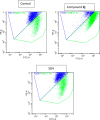Design, Synthesis, and Biological Evaluation Studies of Novel Naphthalene-Chalcone Hybrids As Antimicrobial, Anticandidal, Anticancer, and VEGFR-2 Inhibitors
- PMID: 36844559
- PMCID: PMC9947975
- DOI: 10.1021/acsomega.2c07256
Design, Synthesis, and Biological Evaluation Studies of Novel Naphthalene-Chalcone Hybrids As Antimicrobial, Anticandidal, Anticancer, and VEGFR-2 Inhibitors
Abstract
Cancer is a progressive disease that is frequently encountered worldwide. The incidence of cancer is increasing with the changing living conditions around the world. The side-effect profile of existing drugs and the resistance developing in long-term use increase the need for novel drugs. In addition, cancer patients are not resistant to bacterial and fungal infections due to the suppression of the immune system during the treatment. Rather than adding a new antibacterial or antifungal drug to the current treatment plan, the fact that the drug with anticancer activity has these effects (antibacterial and antifungal) will increase the patient's quality of life. For this purpose, in this study, a series of 10 new naphthalene-chalcone derivatives were synthesized and their anticancer-antibacterial-antifungal properties were investigated. Among the compounds, compound 2j showed activity against the A549 cell line with an IC50 = 7.835 ± 0.598 μM. This compound also has antibacterial and antifungal activity. The apoptotic potential of the compound was measured by flow cytometry and showed apoptotic activity of 14.230%. The compound also showed 58.870% mitochondrial membrane potential. Compound 2j inhibited VEGFR-2 enzyme with IC50 = 0.098 ± 0.005 μM. Molecular docking studies of the compounds were carried out by in silico methods against VEGFR-2 and caspase-3 enzymes.
© 2023 The Authors. Published by American Chemical Society.
Conflict of interest statement
The authors declare no competing financial interest.
Figures





Similar articles
-
Novel thienopyrimidine-aminothiazole hybrids: Design, synthesis, antimicrobial screening, anticancer activity, effects on cell cycle profile, caspase-3 mediated apoptosis and VEGFR-2 inhibition.Bioorg Chem. 2021 Sep;114:105137. doi: 10.1016/j.bioorg.2021.105137. Epub 2021 Jul 1. Bioorg Chem. 2021. PMID: 34237644
-
Molecular Docking and In Vitro Anticancer Screening of Synthesized Arylthiazole linked 2H-indol-2-one Derivatives as VEGFR-2 Kinase Inhibitors.Anticancer Agents Med Chem. 2022;22(11):2166-2180. doi: 10.2174/1871520621666211118102139. Anticancer Agents Med Chem. 2022. PMID: 34792005
-
Design, Microwave-Assisted Synthesis, Antimicrobial and Anticancer Evaluation, and In Silico Studies of Some 2-Naphthamide Derivatives as DHFR and VEGFR-2 Inhibitors.ACS Omega. 2022 Sep 9;7(37):33614-33628. doi: 10.1021/acsomega.2c05206. eCollection 2022 Sep 20. ACS Omega. 2022. PMID: 36157776 Free PMC article.
-
Targeting the interplay between MMP-2, CA II and VEGFR-2 via new sulfonamide-tethered isomeric triazole hybrids; Microwave-assisted synthesis, computational studies and evaluation.Bioorg Chem. 2022 Jul;124:105816. doi: 10.1016/j.bioorg.2022.105816. Epub 2022 Apr 16. Bioorg Chem. 2022. PMID: 35489270 Review.
-
Novel benzothiazole-based dual VEGFR-2/EGFR inhibitors targeting breast and liver cancers: Synthesis, cytotoxic activity, QSAR and molecular docking studies.Bioorg Med Chem Lett. 2022 Feb 15;58:128529. doi: 10.1016/j.bmcl.2022.128529. Epub 2022 Jan 7. Bioorg Med Chem Lett. 2022. PMID: 35007724 Review.
Cited by
-
Synthesis and Anticancer Activities of Pyrazole-Thiadiazole-Based EGFR Inhibitors.ACS Omega. 2023 Aug 17;8(34):31500-31509. doi: 10.1021/acsomega.3c04635. eCollection 2023 Aug 29. ACS Omega. 2023. PMID: 37663500 Free PMC article.
-
Dual anticancer and antibacterial activity of fluorescent naphthoimidazolium salts.RSC Adv. 2023 Dec 14;13(51):36430-36438. doi: 10.1039/d3ra06555c. eCollection 2023 Dec 8. RSC Adv. 2023. PMID: 38099251 Free PMC article.
-
Identification of a New Pentafluorosulfanyl-Substituted Chalcone with Activity Against Hepatoma and Human Parasites.Pharmaceuticals (Basel). 2025 Jan 3;18(1):50. doi: 10.3390/ph18010050. Pharmaceuticals (Basel). 2025. PMID: 39861113 Free PMC article.
References
-
- El Ghalia H.; Amina G.; El Aissouq A.; Oussama C.; Hicham E. H.; Abdelkrim O.; Mohammed B. A quantitative study of the structure-activity relationship and molecular docking of 5.6. 7-trimethoxy-N-aryl-2-styrylquinolin-4-amines as potential anticancer agents using quantum chemical descriptors and statistical methods. J. Mol. Struct. 2022, 1270, 133794.10.1016/j.molstruc.2022.133794. - DOI
-
- Qi B.; Wang F.; He H.; Fan M.; Hu L.; Xiong L.; Gong G.; Shi S.; Song X. Identification of (S)-1-(2-(2, 4-difluorophenyl)-4-oxothiazolidin-3-yl)-3-(4-((7-(3-(4-ethylpiperazin-1-yl) propoxy)-6-methoxyquinolin-4-yl) oxy)-3, 5-difluorophenyl) urea as a potential anti-colorectal cancer agent. Eur. J. Med. Chem. 2022, 239, 114561.10.1016/j.ejmech.2022.114561. - DOI - PubMed
-
- JawalePatil P. D.; Bhamidipati K.; Damale M. G.; Sangshetti J. N.; Puvvada N.; Bhosale R. S.; Ingle R. D.; Pawar R. P.; Bhosale S. V.; Bhosale S. V. Synthesis of naphthalimide derivatives bearing benzothiazole and thiazole moieties: In vitro anticancer and in silico ADMET study. J. Mol. Struct. 2022, 1263, 133173.10.1016/j.molstruc.2022.133173. - DOI
-
- Pérez-Soto M.; Peñalver P.; Street S. T.; Weenink D.; O’Hagan M. P.; Ramos-Soriano J.; Jiang Y. J.; Hollingworth G. J.; Galan M. C.; Morales J. C. Structure-activity relationship studies on divalent naphthalene diimide G quadruplex ligands with anticancer and antiparasitic activity. Bioorg. Med. Chem. 2022, 71, 116946.10.1016/j.bmc.2022.116946. - DOI - PubMed
- Wang X.; Lu Y.; Sun D.; Qian J.; Tu S.; Yue W.; Lin H.; Tang H.; Meng F.; He Q.; et al. Discovery of 4-methoxy-N-(1-naphthyl) benzenesulfonamide derivatives as small molecule dual-target inhibitors of tubulin and signal transducer and activator of transcription 3 (STAT3) based on ABT-751. Bioorg. Chem. 2022, 125, 105864.10.1016/j.bioorg.2022.105864. - DOI - PubMed
- Gurung S. K.; Kumari S.; Dana S.; Mandal K.; Sen S.; Mukhopadhyay P.; Mondal N. DNA damage, cell cycle perturbation and cell death by naphthalene diimide derivative in gastric cancer cells. Chem-Bio. Interact. 2022, 358, 109881.10.1016/j.cbi.2022.109881. - DOI - PubMed
- Husseiny E.; El menofy N.; El-Sebaey S. 1,8-Diaminonaphthalene-derived pharmacophore as potent anti-MRSA with dual DNA gyrase and topoisomerase IV inhibition. Egypt. J. Chem. 2021, 65 (3), 1–17. 10.21608/ejchem.2021.104410.4824. - DOI
- Alorini T. A.; Al-Hakimi A. N.; El-Sayed Saeed S.; Alhamzi E. H. L.; Albadri A. E. A. E. Synthesis, characterization, and anticancer activity of some metal complexes with a new Schiff base ligand. Arab. J. Chem. 2022, 15 (2), 103559.10.1016/j.arabjc.2021.103559. - DOI
LinkOut - more resources
Full Text Sources
Molecular Biology Databases
Research Materials

